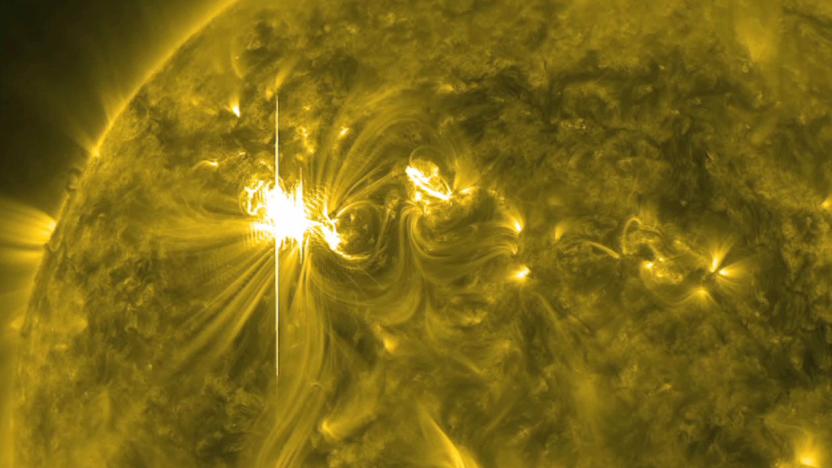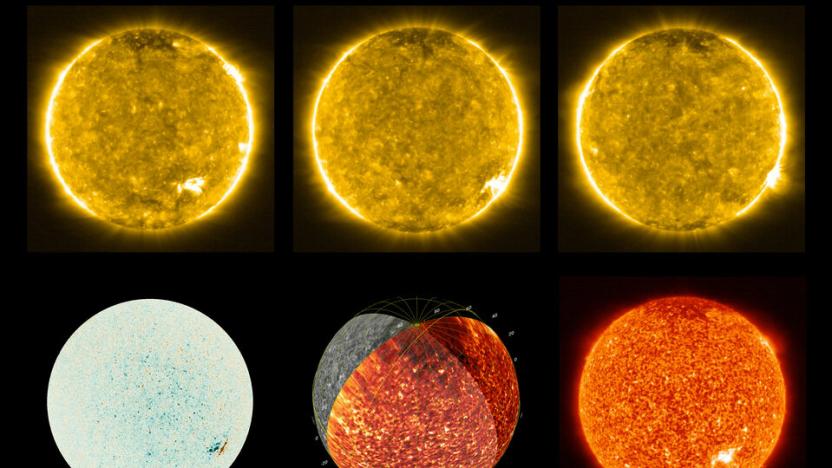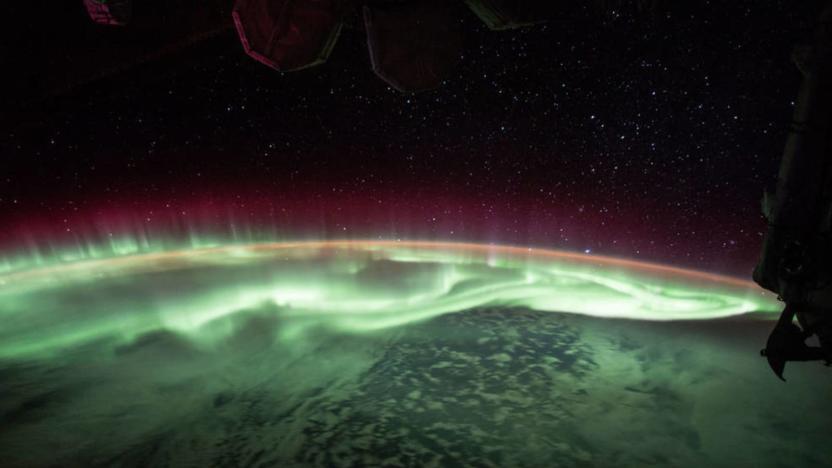solar flares
Latest

Newly signed law aims to limit the damage from space weather
A newly signed law, the PROSWIFT Act, will help predict and limit the damage from solar flares and other space weather.

NASA and ESA share the closest images ever taken of the Sun
NASA and ESA share the first images taken by their Solar Orbiter. They're the closest pictures ever taken of the sun.

NASA ramps up its efforts to understand space weather
This week, NASA selected three proposals for missions that could help us better understand the Sun-driven space weather that occurs near Earth. Space weather, like solar flares, can impact spacecraft and astronauts, and it has the potential to disable utility grids on the ground. As NASA prepares to send more astronauts to space and we become increasingly reliant on technology, the need to protect both has become more pressing.

NASA will study solar weather in two new missions
Solar winds are no threat to people on Earth, but can pose a danger to astronauts and spacecraft. NASA has selected two new missions that aims to better our understanding of how the Sun drives extreme space weather. The first mission, Polarimeter to Unify the Corona and Heliosphere (or PUNCH) will consist of four suitcase-shaped satellites that will track solar wind as it leaves the sun. The second, Tandem Reconnection and Cusp Electrodynamics Reconnaissance Satellites (or TRACERS) will use two spacecraft to study how magnetic fields around Earth interact with the Sun.

IBM cluster powers Murchison Widefield Array's radio telescope, answers mysteries of the universe faster than ever (video)
Radio telescope operators have as much of a problem coping with the avalanche of data as getting that information in the first place. The Victoria University of Wellington is all too aware and is leaning on IBM for a powerful (if very tongue-tying) iDataPlex dx360 M3 compute cluster to sift through the deluge at the upcoming Murchison Widefield Array. Combined, the 4,096 array antennas probing deep space and solar atmospherics will have the Xeon-based cluster tackling signal data to the tune of 8GB per second, and about 50TB per day -- that's a Nexus 7's worth of astronomy faster than you can sneeze, folks. A 10Gbps network connection will feed the results to Perth to save scientists a roughly 435-mile trek. Construction is still in mid-stride, but the $51 million Australian ($52.2 million US) being spent on the Murchison array may be worthwhile if it helps solve the riddles of star formation and solar flares.

'Extreme' class solar flare heading toward Earth, hopefully bringing nothing but auroras
Yesterday, a solar flare set off from the sun, launching a coronal mass ejection (CME) heading toward Earth, and it's set to make an appearance in our fair skies this Saturday. While the wave of charged particles headed our way is much weaker than the most powerful solar flares (like the X28+ gust from 2003), it ranks in the extreme (X) class, and it's already caused a wave of UV radiation that interfered with radio signals, not to mention an uptake in solar protons swarming around Earth. According to SpaceWeather.com, the flare could cause some geomagnetic storms, which could endanger satellites and astronauts in space in addition to possibly interfering with communication signals. That (relatively minor) risk aside, those of you living up north could be in for a pretty sweet light show, so check the skies for the aurora borealis.

Keep your eyes on the Sun safely with free 3D Sun app
I really love to find cool, free apps, and I have a good one for you. 3D Sun, developed in collaboration with NASA scientists, will alert you to solar flares and storms which can disrupt communications on earth and trigger spectacular northern lights. Activating the push feature provides instant notification of major solar activity.. Clicking on the app will give you detailed information, as well as a current picture of the surface of the sun provided by the NASA 'Stereo' satellites. You can rotate the view of the sun with your fingers, and pinch in and out to zoom. The 2 satellites don't have a 360 degree view, so there will be a dark sliver where the cameras can't see. Using this app is a lot safer than trying to see these phenomena with the naked eye or even using some of the not-so-safe solar filters that are around. In addition to the 'live' view of the sun, you can view recent pictures of the sun in different bands of the spectrum, and you'll get a look at the rather fascinating magnetic field lines that are above the surface of our friendly orb. The app also features a collection of stills and movies showing solar events and events triggered by the sun. The app is just out, so grab it if you are interested. I'd also remind our scientifically prone readers of the terrific NASA app that Steve Sande reviewed in October. 3D Sun has scads of images, videos, launch information and more, and it's another freebie. These apps run on the iPhone and the iPod touch. I think you should go for launch on both of these. A-OK? Check the gallery for more screen shots: %Gallery-85941%

Solar flares set to wreak havoc on GPS signals
The sun's activity isn't usually a hot topic around these parts, but when it threatens to derail satellite navigation services around the world, it must surely take center stage. UK researchers have corroborated Cornell's 2006 warning that our solar system's main life-giver is about to wake up and head toward a new solar maximum -- a period of elevated surface activity and radiation. It is precisely that radiation, which can be perceived in the form of solar flares, that worries people with respect to GPS signaling, as its effects on the Earth's ionosphere are likely to cause delays in data transmission from satellites to receivers and thereby result in triangulation errors. Still, it's more likely to be "troublesome than dangerous," but inaccuracies of around 10 meters and signal blackouts that could last for hours are being forecast in the absence of any intervening steps being taken. So yes, you now have another reason not to trust your GPS too much. [Thanks, Mike]

Scientists pinning dropped calls on... solar flares?
Dropped calls have admittedly become less of a problem as carriers became more reliable in more locales, but it sounds like we finally have somewhat of a celestial answer as to why they happen in the first place. Thanks to research by David Thomson and colleagues at Queen's University in Canada (pictured above), they have discovered that when a "solar radio flare occurs and cell-site antennae are facing the sun, the number of dropped calls that go away for no apparent reason increases dramatically." In one particular case, it was noted that "20-percent of calls" were dropped during flares, and while some may be satisfied with cranking out these results and darting away, the team is still interested in finding out the reasons why calls still drop in the absence of flares. And to think, all this time we were having way too much fun blaming the carriers.[Via Textually]

Solar flares to disrupt GPS for several hours in 2011 or 2012
Ok GPS fans, we're prepping you early for what could be a moment of pretty severe inconvenience in the not so distant future. Brace yourself, because in roughly five to six years, your beloved handheld devices won't work for several hours due to solar flare activity (sound familiar?). According to new Cornell University research, solar flares negatively affect GPS devices, based on observations of stellar phenomena in September of last year. In 2011 or 2012, when the sun reaches its next solar maximum, scientists expect it to cause a 90 percent GPS signal drop for several hours. While most of us will walk around, oblivious to these space fireworks, Alessandro Cerruti (pictured on the left), a Cornell graduate student who studies solar flare effects, envisions this horrific day as a "nightmare situation," given that all planes will likely have GPS signaling by that time. However, given these harbingers of doom, Dr. Paul Kinter (pictured on the right), Cerruti's advisor, has a brilliant solution: "I think the best remedy is to be aware of the problem and operate GPS systems with the knowledge that they may fail during a solar flare." See, it's just that easy, people.




